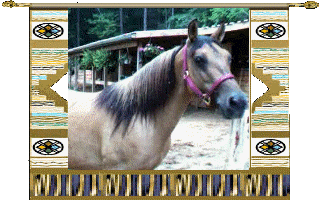FOSTER PARENTS -- Fred and Sherryl Fitzwater pause for a moment with with one of the their Sulphur Mustangs, Pepper, in a corral at their Bray Ridge Farm, in northwest Alexander County. Pepper hails from the remote Sulphur Springs area of Utah, where the breed of Spanish Mustangs has sequestered itself, keeping the bloodline remarkably pure.
Alexander residents adopt little-known breed of horse
By MICAH HENRY
Some Alexander County residents may have pets such as dogs, cats, or goldfish. For Little River residents Fred and Sherryl Fitzwater, that list is just the beginning.
The Fitzwater’s have many animals at their Bray Ridge Farm, located northwest of Taylorsville, but they are perhaps the most proud of the newest addition to their “family,” a Sulphur Mustang named Dreamweaver.
Dreamweaver is the newest of four Sulphur Mustangs to call the Fitzwater’s farm home. The others include Pepper, a seven-year old bay mare, her foal named Rainmaker, and a two year-old filly named Little Bit.
Sherryl Fitzwater’s love of horses started early in life. Her grandfather raised quarter horses on his farm and Fitzwater fell in love with the animals as a child, often participating in horse shows when she was young to which she carries on to this day. The Fitzwaters have been in Alexander County since 1989.
Visiting the Fitzwaters at the time they were interviewed for this article was Catawba County resident and long-time horseman, Rob Martin, who has a burgeoning interest in the Sulphur breed.
Fred and Sherryl Fitzwater met Martin through a mutual acquaintance at the Lazy P Ranch tack shop in Bethlehem.
The Sulphur Mustangs are from the Sulphur Springs region of Utah (hence the name), and the breed has largely kept itself sequestered in the higher altitudes of the area. This has limited the inter-mingling of Sulphur blood with the other breeds of horses found in the area.
According to Dr. E. Gus Cothran, Director of the Equine Bloodtyping Research Laboratory at the University of Kentucky, the breed is very pure.
“The Sulphur horses have the highest similarity to Spanish Type horses of any wild horse population in the U.S. that I have tested. They definitely have Spanish ancestry and possibly are primarily derived from Spanish horses,” said Dr. Cothran.
The Bureau of Land Management (BLM) governs the adoption of these and other controlled horses through their National Wild Horse and Burro Program.
Fred Fitzwater explained why he and his wife wanted to adopt a Sulphur Mustang, saying that, in the wild, these horses have a harsh life.
“A lot of them are starving to death, just falling over dead,” said Fred Fitzwater. “Let the horses roam free, I agree, that’s our heritage, but not to [let them] starve, not to die a cruel death.”
The region in which these horses come from in Utah, said Martin, is a very harsh locale.
“The BLM just doesn’t have enough personnel to check up on every one,” said Martin. “And in their area, the food is scarcer and water is scarcer. Where these particular horses are, it’s worse than others.”
The Fitzwaters witnessed firsthand, what effect the harsh conditions can have on a horse when they decided to adopt their first Sulphur, Pepper.
“When we got her, she was just skin and bones,” said Fred Fitzwater, of their adopted horse, Pepper.
“When we got her,” said Sherryl Fitzwater, “I could put my hands around her neck, and she was pregnant!”
Indeed, the horse had led a hard life before she came to live on the Fitzwater’s farm. But the couple points out that not only did Pepper survive, but she also carried her foal full term and it was delivered well and is alive today. This has assured the Fitzwaters of the remarkable stamina of these horses.
“They don’t need shoes,” said Rob Martin. He noted that the horses’ hooves are so hard that horseshoes are not needed, even in rocky terrain.
The Sulphurs have several colorings associated with them, including duns, bays, chestnuts, grullas, as well as less common palominos, and blacks.
The horses are marked for identification by the BLM with what is known as a signalment brand, according to Martin. It is placed upon the left side of the horse’s neck and contains symbols denoting the state and location in which the horse was captured. This allows the BLM to instantly identify the horse, where and when it was captured, and records will show who adopted the horse.
The Bureau has a website for online aficionados wishing to learn about horse adoption at www.adoptahorse.blm.gov.
Sherryl Fitzwater has a webpage showcasing her Sulphur Mustangs located online at http://www.SulphurHorseRanch.com
There is also a website devoted to the Sulphur horse breed at www.americanspanishsulphur.org
Advertisers
Joel Harbinson, Attorney
Hidden Crystal Inn
Millsaps Realty
Target Insurance
T-Sport Shop
Wildflowers
Carrigan Pet Sitting
Back To Top
Serving Alexander and Surrounding Counties since 1886
© 2001 Taylorsville Times - All Rights Reserved
Designed by


